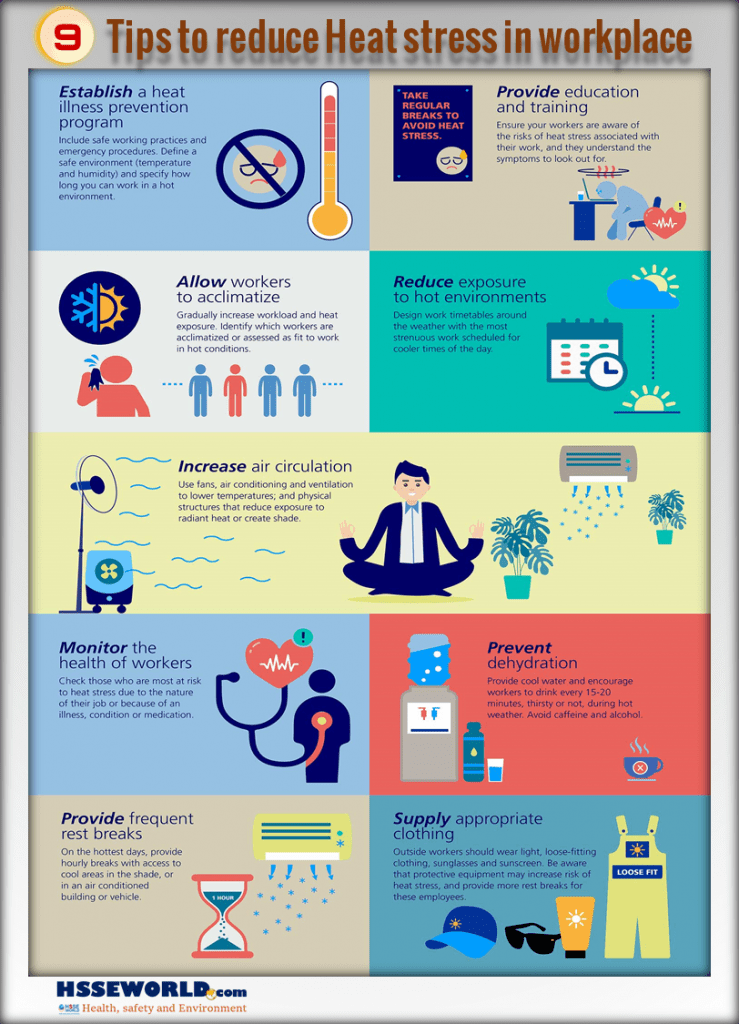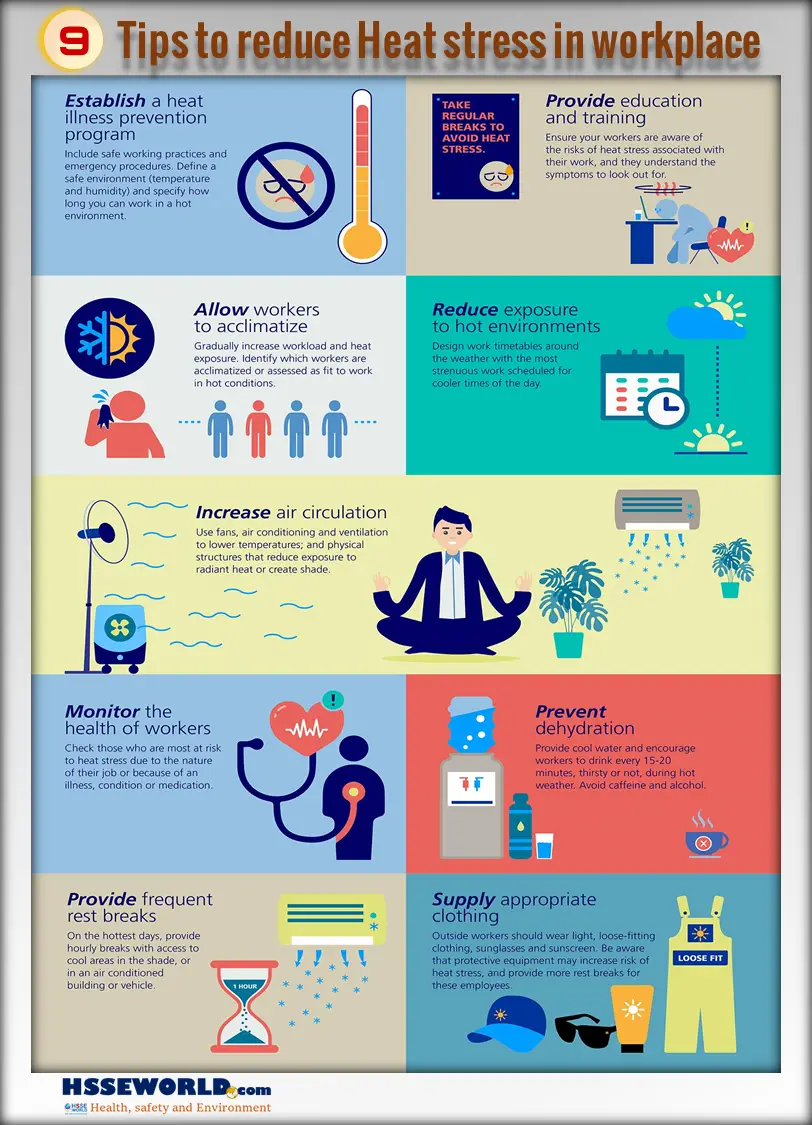Summer is starting with a bang this year as a heatwave moves from the Midwest to the East coast. For employees working outdoors or in hot indoor environments, the heat can lead to serious illness.
Heat and humidity are a serious safety threat to workers during the summer from utility workers to agriculture, construction, firefighters, roadway workers, and more, People should heed the heat warnings and act quickly when they begin to feel any heat-related symptoms.
in the photo of today, we will outline tips to reduce heat stress in the workplace to avoid heat-related illness

There are numerous jobs throughout the country that involve hot environments, both indoors and out. And since working in these conditions can affect the body’s ability to cool itself down, workers must be educated about the dangers of heat stress and how to prevent it.
There are more workers at risk of heat stress than you might think. Some common industries with hot work environments include:
- Construction
- Roofing
- Road construction
- Forest fire fighting
- Pulp and paper manufacturing
- Industrial laundries
- Bakeries
- Steel manufacturing and fabricating
- Boiler rooms
- Working near cement kilns
Here, we’ll go over some heat stress basics and then discuss seven key ways to prevent heat stress before it has a chance to take hold.
What You Need to Know About Heat Stress
Our bodies naturally maintain a consistent temperature (usually ranging from 36 to 38°C, or 96.8 to 100.4°F). When the body’s core temperature rises above this range, it reacts to get rid of that excess heat. But if we gain heat faster than we can release it, our body temperature increases and we experience what’s known as heat stress.
Heat stress isn’t an illness in and of itself. It’s actually a collective term for three heat-related illnesses:
- Heat cramps
- Heat exhaustion
- Heatstroke
(Learn more about The Dangers of On-the-Job Dehydration.)
Key Contributors to Heat Stress
There are three key factors that contribute to the onset of heat stress. If you want to prevent heat stress, you need to consider all of these:
Environmental
- Air temperature
- Airflow
- Humidity
- Radiant heat (e.g. from the sun or a kiln)
Work
- Workload
- Work rate
Worker
- Acclimatization
- Hydration
- Clothing
- Medical conditions
How to Stop Heat Stress in Its Tracks
Luckily for workers, there are a number of easy ways to keep heat stress at bay. Here are seven of the best.
1. Stay Fit
Excess body fat insulates the body, which causes it to retain heat. That means people who are physically fit and in a healthy weight, range are able to better handle (or ward off) heat stress than those who aren’t.
Workers who want to stay fit are encouraged to do regular aerobic activities like walking, running, cycling, or swimming.
2. Pre-hydrate
Arriving to work already dehydrated puts you at a much greater risk for developing heat stress. Workers should come to work fully hydrated by drinking up to 16 ounces of fluid before work begins. Once work activities start, workers should drink about 8 ounces every 15 to 20 minutes to replace the fluids they lose through perspiration (find out why Hydration in the Workplace Is Not Just a Summer Issue).
3. Replace Electrolytes Throughout Your Shift
Low or out-of-balance electrolytes (often caused by intense sweating) contribute to the onset of heat cramps and heat exhaustion. Workers who spend more than an hour at a time in hot environments should add electrolytes to their fluids, which helps replace the sodium lost through perspiration.
4. Cover-up Exposed Skin – Except on Your Head
Many of us believe that wearing a hat helps prevent heat-related illnesses from taking hold. But safety experts recommend wearing visors instead of full hats, as they can restrict heat loss through the head.
You do want to cover other exposed areas, though. Wearing loose, lightweight, synthetic long-sleeve shirts and long pants can actually help you stay cool as the sweat on your skin evaporates. Avoid cotton, as it tends to soak up sweat and prevent evaporation.
5. Use Sunscreen
People often think of sunscreen as a way to prevent sunburns, not heat stress. But the Mayo Clinic notes that sunburns actually contribute to the development of heat stress by preventing the body from being able to properly cool itself. They recommend using a broad-spectrum sunscreen with an SPF of at least 15, and reapplying it generously every two hours (or more, if you’re sweating excessively). Ideally, choose a natural sunscreen that is free of chemicals like oxybenzone, avobenzone, octisalate, and homosalate.
6. Take Regular Breaks
Establishing adequate work-rest cycles gives workers time to cool down throughout the workday. These breaks should be scheduled and strictly enforced and should take place in a cool, shaded area or an area with good ventilation. Plenty of cool fluids should be made available to the workers as well.
7. Acclimatize Slowly
Throwing yourself into work in a hot environment puts you at significant risk for heat stress. Instead, experts recommend exposing yourself to the hot environment slowly, over five to seven days.
New workers should increase their time spent in the heat by about 20 percent each day, while workers who are already used to hot conditions can increase their exposure a bit more rapidly. However, any worker who has spent four or more days out of the heat must re-acclimatize.
conclusion
Heat stress is treatable, but why treat it when you could prevent it altogether? A combination of smart work practices and administrative controls will help your workers stay safe in the heat and keep focused on the task at hand.
Download Infographic
9 Tips to reduce Heat stress in the workplace
More Photos
- What are the Best Practices for Managing Subcontractor Risk
- Photo of the day: 10 Essential Safety Tips for Driving in Hot Weather Conditions
- Photo of the day: best workplace safety tips
- Photo of the day: The Importance of Stop Work Authority in Maintaining Workplace Safety
- Photo of the day: Tomorrow’s Reward for Working Safely Today: Cultivating a Culture of Safety
- Photo of the day: Preventing slips and trips at work
- Photo of the day: Learn the DRSABCD action Plan
- Working with Electricity Electrical Accidents Guide for Electrical Workers
- Photo of the day: Hearing Protection Device Selection
- Photo of the day: If An Earthquake Shakes You-Infographic free
- Fire Safety Posters Free Download
- Photo of the day: First Aid for Electrical Burns-Infographic free
- Infographic: First Aid for Cuts and Scrapes free download
- Photo of The day: Work Safe with Lasers-Laser Safety free
- Photo of the day: Working Safely with chemicals and chemical Management
- Photo of the day: Safe work practices when using MEWPs ( updated)
- Photo of the day: Preventing Common Kitchen Hazards
- Photo of the day: Safe handling of Gas Cylinders and lecture bottles
- Photo of the day: Forklift Stability Triangle
- Photo of the day: Defective Tools Safe Work Practice
- Photo of the day: Lift With Your Legs Not With Your Back
- Photo of the day: First Aid for burns
- Photo of the day: The 7 Principles of HACCP
- Photo of the day: Working Safely with Suspended Loads
- Photo of the day: Heat Stroke First Aid and safety posters
- Photo of the day: Near-Miss Reporting and Posters
- Photo of the day: Ergonomic chair and office chair safety tips
- Photo of the day: Whole Body Vibration
- Photo of the day: Substation Safety Equipment
- Photo of the day: Bypassing Safety Controls Rules
- Photo of the day: Lightning Safety Tips
- Photo of the day: Overhead Power lines Clearance
- Photo of the day: Floor Marking
- Photo of the day: Types of Foot Protection
- Photo of the day: Types of Hand Protection
- Photo of the day: Lockout and Tagout Safety
- Photo of the day: Fall Protection Plans
- Photo of the day: Flood Safety Tips
- Photo of the day: Read All Labels Work safe
- Photo of the day: Run Project safely with Crane Hand Signals
- Photo of the day: Flagman and Traffic control
- Photo of the day: Managing Risks of Exposure to Solvents in the workplace
- Photo of the day: Scissor Lift Safety
- Photo of the day: HSE Bulletin Board
- Photo of the day: Arc-Fault Circuit Interrupters (AFCI)
- Photo of the day: Safe use of ladders and step ladders
- Photo of the day: Concrete Truck Driver Hand Signals
- Photo of the day: Extension Cord Safety Tips
- Photo of the day: Protect your Head
- Photo of the day: choosing the right Anchorage
- Photo of the day: Work-Related Asthma
- Photo of the day: Top FIVE Heavy Equipment Construction Site Safety Tips
- Photo of the day: sun safety in the workplace
- Photo of the day: Cannabis and Impairment in the Workplace
- Photo of the day: Position for safety and comfort-Safety Tips
- Photo of the day: Generator Safety
- Photo of the day: Controlling COVID-19 in the Workplace-Physical Barriers
- Photo of the day: Manual Material handling
- Photo of the day: Personal Protective Equipment last resort
- Photo of the day: WHMIS 2015 – Pictograms
- Photo of the day: Indoor Air Quality
- Photo of the day: Noise in the affected workplace
- Photo of the day: Fatigue at Work
- Photo of the day: Don’t be Driven to Distraction
- Photo of the day: working in heat and Humidex Rating
- How to use Plate Clamps Safely: Safety Moment#34
- Photo of the day: Sitting at work
- Photo of the day: 5 ways to reduce the risk of Slipping and Tripping
- Photo of the day: Preventing the spread of contagious illness
- Photo of the day: Incident Investigations
- Photo of the day: 10 Scaffold Safety Essentials
- Photo of the day: Effective Health and Safety Committees
- Photo of the day: New worker Orientation & Safety Orientation checklist
- Photo of the day: Workplace Inspection
- Photo of the day: musculoskeletal disorders
- Photo of the day: Emergency preparedness in the workplace
- Photo of the day: Mental health in the workplace
- Photo of the day: Trenching Safety Tips That Can Save a Life
- Photo of the day: Dangerous Goods Classes
- Photo of the day: Safety Equipment for Confined Spaces
- Photo of the day: Tips to reduce Heat stress in the workplace
- Photo of the day: hierarchy of controls
- Your steps to chemical safety
- H2S Gas and how to handle its Emergency
- Photo of the day: Importance of Mock drill and Fire Action Emergency Procedure
- Photo of the day: Choosing the Right Face Mask and the difference between a respirator and face mask
- Photo of the day: Confined space safety Precautions
- Breath Safely: The Proper Use of Respiratory Protection
- Photo of the day: Electric shock survival
- Photo of the day: Chemical Spill Emergency Response
- Photo of the day: Construction Site fire Safety




